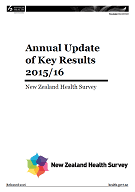
Summary
This report provides a snapshot of the health of New Zealanders through the publication of key indicators on health behaviours, health status and access to health care for both adults and children.
This report presents the 2015/16 results from the continuous New Zealand Health Survey, with comparisons to the 2011/12 and 2006/07 surveys.
You can find the report and data tables in the Downloads section of this page. Results are available by sex, age group, ethnic group and neighbourhood deprivation.
These statistics have been incorporated in the most recent version of the Data Explorer (updated in December 2023):
The data in these tables can be downloaded in a machine-readable format.
If you have any queries please email [email protected]
Please ensure to use the latest and most comprehensive annual results. We have made changes to previously published data. The errors are described in the latest Methodology Report.
Overview of key findings
Health status, health behaviours and risk factors
- Most New Zealanders report being in good health.
- The smoking rate has decreased since 2006/07. The most substantial reduction in current smoking since 2006/07 has been for 15–17 year-olds, 6% of whom smoked in 2015/16, compared with 16% in 2006/07.
- Child obesity rates have stabilised to 2011/12 rates.
- The hazardous drinking rate has increased since 2006/07.
- Māori, Pacific peoples and those living in the most deprived areas generally report poorer health than others. Asian health is generally good.
Health conditions
- More than one in five adults (21%) experience chronic pain, up from 17% in 2006/07.
- The prevalence of psychological distress (indicative of an anxiety or depressive disorder) is lower in adults over 65 years of age than in other adult age groups. Prevalence of psychological distress is 3.1 times higher in adults living in the most deprived neighbourhoods than in the least deprived neighbourhoods.
Access to health care
- Most children had their last visit with a GP, practice nurse or after-hours medical centre for free
- The percentage of adults and children unable to collect a prescription item due to cost in the past 12 months has fallen since 2011/12
- Māori, Pacific peoples and those living in the most deprived areas generally report greater unmet need for primary care than others.
Oral health
- Māori and Pacific children and adults, and those living in the most deprived areas have high rates of tooth extractions in the past year.
- Most children have visited a dental health care worker in the past year.
- Nearly half of adults with natural teeth visited a dental health care worker in the past year.
